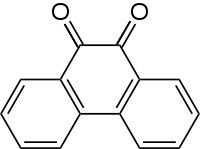Phenanthrenequinone
Not to be confused with Phanquinone.
 | |
| Names | |
|---|---|
| Systematic IUPAC name
9,10-Phenanthrenequinone[1] | |
| Identifiers | |
| 84-11-7 | |
| ChEBI | CHEBI:37454 |
| ChemSpider | 6505 |
| PubChem | 6763 |
| UNII | 42L7BZ8H74 |
| Properties | |
| C14H8O2 | |
| Molar mass | 208.22 g·mol−1 |
| Appearance | Orange solid |
| Odor | Odorless |
| Melting point | 209 °C (408 °F; 482 K) |
| Boiling point | 360 °C (680 °F; 633 K) |
| Slightly soluble (7.5 mg L−1) | |
| Hazards | |
| Safety data sheet | External MSDS |
| GHS pictograms |   |
| GHS signal word | Warning |
| H315, H319, H400 | |
| P273, P264, P280, P305+351+338, P337+313, P302+352, P332+313, P362, P391, P501 | |
| R-phrases | R36 R68 R50 |
| S-phrases | S26 S36/37 S57 |
| NFPA 704 | |
| Except where otherwise noted, data are given for materials in their standard state (at 25 °C [77 °F], 100 kPa). | |
| Infobox references | |
Phenanthrenedione is a cytotoxic derivative of the polycyclic aromatic hydrocarbon phenanthrene.[2]
References
- ↑ " 84-11-7|Phenanthrenequinone|Toxnet|". nih.gov.
- ↑ Robert A. Kanaly; Natsuko Hamamura (September 2013). "9,10-Phenanthrenedione biodegradation by a soil bacterium and identification of transformation products by LC/ESI-MS/MS". Chemosphere. 92 (11): 1442–1449. doi:10.1016/j.chemosphere.2013.03.054. Retrieved 8 March 2016.
This article is issued from Wikipedia - version of the 3/23/2016. The text is available under the Creative Commons Attribution/Share Alike but additional terms may apply for the media files.
